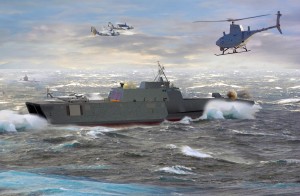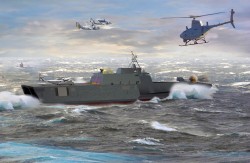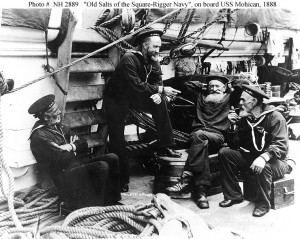
Using historical examples and parallels to predict the future can be dangerous, but is better than operating in a vacuum. It can also serve to break down to relatively simple and illustrative terms sometimes overwhelming complexities, in contrast with the more sophisticated analytic tools available. The simpler method further helps to mitigate the marvelous talent of the human mind to justify whatever it is we want justified by framing the arguments in easy to follow logic. What does this extended introduction say about LCS’ future development? LCS has quite a long story, which CAPT Carney Powers tells in the pages of Proceedings’ September issue. But if we draw a line between the past and present and try to answer the simple question, “What is LCS?” in no more than 10 words, my attempt would be something like this:
LCS screens battle force from asymmetrical threat of the time.
100 years ago, in 1912, the asymmetrical threats to a battle force were the torpedo, carried by the already well established flotillas of torpedo boats, and the rapidly maturing technology of submarines. In this respect LCS is similar to early destroyers, which were basically outgrown torpedo boats. Its mission was defined in the most direct way by the French name of this new class of ships – contre-torpilleur. They were better fighting small and agile torpedo boats than cruisers, which formed the battle-force screen of the time, but they lacked seakeeping and range to keep pace with the fleet. With time, due in part to the growing threat from submarines and later aircraft, destroyers evolved into two subcategories – escort and fleet destroyers. In his recently published interview, Dr. John Lehman points to the problem of LCS’ inability to deploy with Carrier Battle Groups as a similarity with the early destroyers, and calls for a battle group-deployable frigate program that would replace the FFG 7s. As FFGs were never intended to be a part of Carrier Battle Groups there is a danger that his idea would end up as an attempt to procure fleet destroyers at the cost of escort destroyers, or using contemporary nomenclature to buy DDGs for the price of FFGs.
Another way to look at LCS could be as a drone carrier. Norman Friedman recently made this kind of parallel. During the interwar period, the U.S. Navy searched for more scouting capabilities by pursuing many ideas in parallel. One of them was a seaplane tender like Curtiss AV-4. The task was to put at sea a maximum number of possible scouting planes. Today we speak about autonomous vehicles but the mission is similar. Quite contrary to destroyers, sea plane tenders disappeared from the seas. What is the difference between these two parallels? Contre-torpilleur is a statement of mission, screening the battle force, while seaplane tender is description of capabilities. Capabilities will naturally evolve with stated mission and technology. The art is to match both at given level of evolution. Our ancestors used to say nihil novi sub sole. Translated into modern language and applied to the Navy we can say that managing the fleet is not a mysterious science but an art of applying already invented ideas.
Przemek Krajewski alias Viribus Unitis is a blogger In Poland. His area of interest is broad context of purpose and structure of Navy and promoting discussions on these subjects In his country


